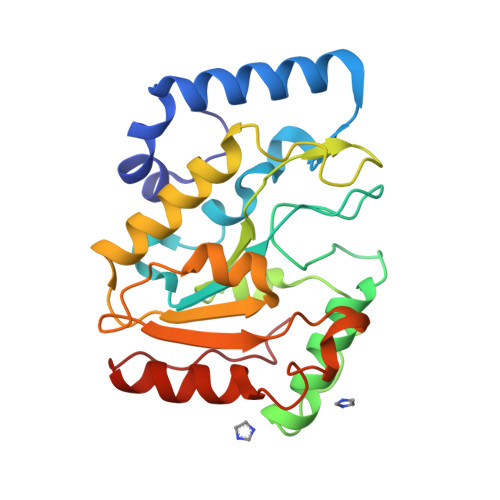Thermal unfolding studies of cold adapted uracil-DNA N-glycosylase (UNG) from Atlantic cod (Gadus morhua). A comparative study with human UNG.
Assefa, N.G., Niiranen, L., Willassen, N.P., Smalas, A., Moe, E.(2012) Comp Biochem Physiol Part B Comp Biochem 161: 60-68
- PubMed: 21959147
- DOI: https://doi.org/10.1016/j.cbpb.2011.09.007
- Primary Citation of Related Structures:
3TKB - PubMed Abstract:
Uracil-DNA N-glycosylase (UNG; EC 3.2.2.27) from Atlantic cod (cUNG) possesses cold adapted features like increased catalytic efficiency and reduced temperature optimum for activity compared to its warm-adapted homologue human UNG (hUNG). Here, we present the first thermal stability analysis of cUNG and hUNG by differential scanning calorimetry (DSC), and the results showed that cUNG is less stable than hUNG and unfolds at a melting temperature (T(m)) 9° lower than its warm-adapted homologue. In addition, an ion-pair (D183-K302) suggested to be crucial for global stability of hUNG was investigated by biochemical characterization and DSC of four mutants (cUNG G183D and cUNG G183D-R302K, hUNG D183G and hUNG D183G-K302R). The hUNG mutants with an expected disruption of the ion-pair showed a slight increase in stability with concomitant reduction in the enzyme activity, while the apparent introduction of the ion-pair in cUNG caused a reduction in the enzyme activity but no increase in stability. Because the mutants did not behave as expected, the phenomenon was further investigated by crystal structure determination. Indeed, the crystal structure of the hUNG D183G-K302R mutant revealed that compensating interactions for the loss of the ion-pair were generated close to and in regions distant from the mutation site. In conclusion, the reduced stability of cUNG supports the suggested requirement of a flexible structure for improved activity at low temperatures. Furthermore, the lack of a direct correlation between enzyme activity and global stability of the mutants supports the significance of distributing locally flexible and/or rigid regions for modulation of enzyme activity.
Organizational Affiliation:
The Norwegian Structural Biology Center (NorStruct), Department of Chemistry, University of Tromsø, N-9037 Tromsø, Norway.



















